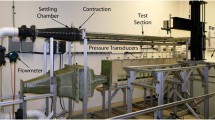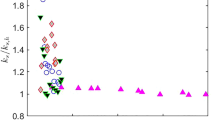Abstract
Three methods have been used to experimentally determine the roughness function (ΔU +) for several rough surfaces. These include the rotating disk, the towed plate, and the velocity profile methods. The first two are indirect methods in as much as they rely on measurements of overall torque or resistance and boundary layer similarity laws to obtain ΔU +, whereas the velocity profile method provides a direct measurement of ΔU +. The present results indicate good agreement between the towed plate and the velocity profile methods for all of the surfaces tested. Tests for the rotating disk were carried out at much higher unit Reynolds numbers. Using this method, the results for sandpaper rough surfaces agree within their uncertainty with a Nikuradse-type roughness function in the fully rough regime, while a spray painted surface agrees with a Colebrook-type roughness function.








Similar content being viewed by others
Abbreviations
- B :
-
smooth wall log-law intercept, =5.0
- C F :
-
overall frictional resistance coefficient, \( = {{\left( {F_{{\text{D}}} } \right)}} \mathord{\left/ {\vphantom {{{\left( {F_{{\text{D}}} } \right)}} {{\left( {\tfrac{1} {2}\rho U_{{\text{e}}} ^{2} S} \right)}}}} \right. \kern-\nulldelimiterspace} {{\left( {\tfrac{1} {2}\rho U_{{\text{e}}} ^{2} S} \right)}} \)
- C f :
-
skin-friction coefficient, \( = {{\left( {\tau _{{\text{o}}} } \right)}} \mathord{\left/ {\vphantom {{{\left( {\tau _{{\text{o}}} } \right)}} {{\left( {\tfrac{1} {2}\rho U_{{\text{e}}} ^{2} } \right)}}}} \right. \kern-\nulldelimiterspace} {{\left( {\tfrac{1} {2}\rho U_{{\text{e}}} ^{2} } \right)}} \)
- C m :
-
torque coefficient, =(2M)/(ρR 5(φω)2)
- F D :
-
drag force
- k :
-
arbitrary measure of roughness height
- K :
-
acceleration parameter, \( = \frac{\nu } {{U^{2}_{{\text{e}}} }}\frac{{{\text{d}}U_{{\text{e}}} }} {{{\text{d}}x}} \)
- L :
-
plate length
- M :
-
torque
- N :
-
number of samples or replicates
- R :
-
disk radius
- R a :
-
centerline average roughness height, \( = \frac{1} {N}{\sum\limits_{i = 1}^N {{\left| {y_{i} } \right|}} } \)
- R q :
-
root mean square roughness height, \( = {\sqrt {\frac{1} {N}{\sum\limits_{i = 1}^N {y^{2}_{i} } }} } \)
- R t :
-
maximum peak to through height, =y max−y min
- R z :
-
ten point roughness height, \( = {\sum\limits_{i = 1}^5 {{\left( {y_{{\max i}} - y_{{\min i}} } \right)}} } \)
- Re L :
-
Reynolds number based on plate length, =U e L/ν
- Re R :
-
Reynolds number based on disk radius, =φωR 2/ν
- Re θ :
-
momentum thickness Reynolds number, =U e θ/ν
- S :
-
wetted surface area
- U :
-
mean velocity in the x direction
- U e :
-
freestream velocity relative to surface
- U τ :
-
friction velocity, \( = {\sqrt {{\tau _{{\text{o}}} } \mathord{\left/ {\vphantom {{\tau _{{\text{o}}} } \rho }} \right. \kern-\nulldelimiterspace} \rho } } \)
- u′:
-
streamwise fluctuating velocity
- ν′:
-
wall-normal fluctuating velocity
- x :
-
streamwise distance from plate leading edge
- y :
-
normal distance from the boundary
- δ :
-
boundary layer thickness
- ΔU + :
-
roughness function
- ΔU +′:
-
roughness function slope, =d(ΔU +)/d(lnk +)
- ε :
-
wall datum offset
- φ :
-
swirl factor, \( = {{\left( {\frac{1} {{{\sqrt {C_{{\text{m}}} } }}}} \right)}_{\infty } } \mathord{\left/ {\vphantom {{{\left( {\frac{1} {{{\sqrt {C_{{\text{m}}} } }}}} \right)}_{\infty } } {{\left( {\frac{1} {{{\sqrt {C_{{\text{m}}} } }}}} \right)}_{{{\text{en}}}} }}} \right. \kern-\nulldelimiterspace} {{\left( {\frac{1} {{{\sqrt {C_{{\text{m}}} } }}}} \right)}_{{{\text{en}}}} } \)
- κ :
-
von Kármán constant, =0.41
- ν :
-
kinematic viscosity of the fluid
- Π :
-
wake parameter
- θ :
-
momentum thickness, \( = {\int\limits_0^\delta {{\left( {1 - \frac{U} {{U_{{\text{e}}} }}} \right)}^{2} {\text{d}}y} } \)
- ρ :
-
density of the fluid
- τ o :
-
wall shear stress
- ω :
-
angular velocity
- +:
-
inner variable (normalized with U τ or U τ /ν)
- en:
-
disk rotating in enclosed tank
- min:
-
minimum value
- max:
-
maximum value
- R:
-
rough surface
- S:
-
smooth surface
- ∞:
-
disk rotating in unconfined fluid
References
Acharya M, Bornstein J, Escudier MP (1986) Turbulent boundary layers on rough surfaces. Exp Fluids 4:33–47
Antonia RA, Krogstad P-Å (2001) Turbulence structure in boundary layers over different types of surface roughness. Fluid Dynam Res 28:139–157
Clauser FH (1954) Turbulent boundary layers in adverse pressure gradients. J Aeronaut Sci 21:91–108
Colebrook CF (1939) Turbulent flow in pipes with particular reference to the transition between smooth and rough pipe laws. J Civil Eng 11:133–157
Coleman HW, Steele WG (1995) Engineering application of experimental uncertainty analysis. AIAA J 33:1888–1896
Coles D (1962) The turbulent boundary layer in a compressible fluid. Report R-403-PR, The Rand Corp.
Granville PS (1958) The frictional resistance and turbulent boundary layer of rough surfaces. J Ship Res 1:52–74
Granville PS (1982) Drag-characterization method for arbitrarily rough surfaces by means of rotating disks. J Fluids Eng 104:373–377
Granville PS (1987) Three indirect methods for the drag characterization of arbitrarily rough surfaces on flat plates. J Ship Res 31:70–77
Grigson CWB (1992) Drag losses of new ships caused by hull finish. J Ship Res 36:182–196
Hama FR (1954) Boundary-layer characteristics for rough and smooth surfaces. Trans SNAME 62:333–351
Klebanoff PS, Diehl FW (1951) Some features of artifically thickened fully developed turbulent boundary layers with zero pressure gradient. NACA TN 2475
Ligrani PM, Moffat RJ (1986) Structure of transitionally rough and fully rough turbulent boundary layers. J Fluid Mech 162:69–98
Loeb GI, Laster D, Gracik T (1984) The influence of microbial fouling films on hydrodynamic drag. In: Costlow JD, Tipper R (eds) Marine biodeterioration, an interdisciplinary study. Naval Institute Press, Annapolis, Md., pp 88–94
Moffat R J (1988) Describing the uncertainties in experimental results. Exp Thermal Fluid Sci 1:3–17
Nikuradse J (1933) Laws of flow in rough pipes. NACA TM 1292
Perry AE, Li JD (1990) Experimental support for the attached-eddy hypothesis in zero-pressure gradient turbulent boundary layers. J Fluid Mech 218:405–438
Raupach MR, Antonia RA, Rajagopalan S (1991) Rough-wall turbulent boundary layers. Appl Mech Rev 44:1–25
Schlichting H (1979) Boundary-layer theory, 7th edn. McGraw-Hill, New York
Schoenherr KE (1932) Resistances of flat surfaces moving through a fluid. Trans SNAME 40:279–313
Schultz MP (2002) The relationship between frictional resistance and roughness for surfaces smoothed by sanding. J Fluids Eng 124:492–499
Schultz MP, Flack KA (2003) Turbulent boundary layers over surfaces smoothed by sanding. J Fluids Eng 125: in press
von Kármán T (1946) On laminar and turbulent friction. NACA TM 1092
Acknowledgements
MPS would like to thank the Office of Naval Research for financial support of this research under the direction of Dr. Steve McElvaney. The authors would also like to acknowledge the ongoing financial support of the disk drag measurements from Mr. William Stoffel (NSWC-Carderock, Code 981, Shipboard R&D Office) and Dr. Alan Roberts (CNO, N420, Energy Plans & Policy). Thanks, as well, to Dr. Eric Holm, Ms. Elizabeth Haslbeck, and Ms. Jean Montemarano from NSWC-Carderock (Code 641) for allowing us to use the rotating disk facility and for providing technical guidance. Many thanks go to Mr. Steve Enzinger, Mr. Don Bunker, and the USNA Hydromechanics Laboratory and Technical Support Division staff for assisting with the project. We are also indebted to Prof. Michelle Koul for helping with the laser profilometry.
Author information
Authors and Affiliations
Corresponding author
Rights and permissions
About this article
Cite this article
Schultz, M.P., Myers, A. Comparison of three roughness function determination methods. Exp Fluids 35, 372–379 (2003). https://doi.org/10.1007/s00348-003-0686-x
Received:
Accepted:
Published:
Issue Date:
DOI: https://doi.org/10.1007/s00348-003-0686-x




